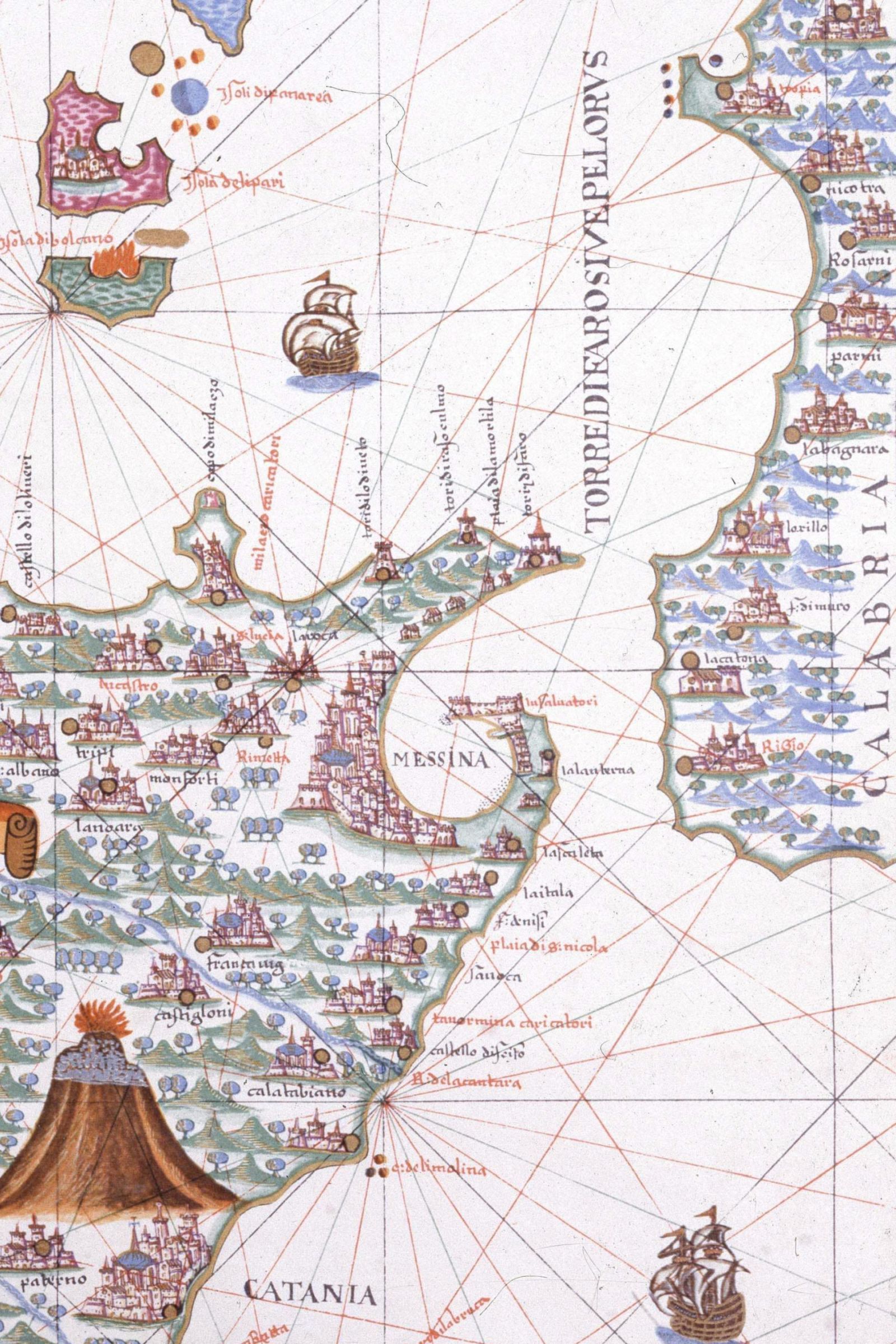Studienkurs
Two Lands / Two Seas: Calabrian-Sicilian Art and Architecture in an Environmental Perspective
Concept and Organization: Sinem Casale, Annette Hoffmann, Lunarita Sterpetti, and Gerhard Wolf

From Joan Martines, Atlas, 1587.
The KHI Summer School 2023 will study the artistic, environmental, and cultural heritage of two lands and two seas, separated or united by a strait, known for its strong currents. The two lands are Calabria and Sicily, the two bodies of water the Tyrrhenian and Ionian Sea, and the Strait is that of Messina.
The area is geologically unstable, due to the encounter of the African and the European plates in a complex system of faults and fractures, which caused catastrophic earthquakes throughout the centuries. It is characterized by the highest European volcano and rugged coastlines, but also a multi-layered cultural past. A strategic zone of contacts, commerce and conflicts in the Mediterranean since ancient times, its premodern history is often told by focusing exclusively on the sequence of political and dynastic domination from Greek colonization, the Roman and Byzantine empires, occupation or governance by Arabs and Normans, as Hohenstaufen territory, followed by Anjou, Aragonese, Spanish, and Bourbon rulership.
Calabria and Sicily witnessed the conflicts and contradictions of the pre- and postunification period. They are at the center of the so-called "southern question", formulated by Gramsci and others. Social deprivation, lack of infrastructure, and catastrophes caused massive depopulation and emigration in the nineteenth and twentieth centuries. In fact, in the mountainous areas of Calabria one can find many abandoned settlements, whereas today the Sicilian and Calabrian coasts are the first European arrival points on migration routes.
The summer school invites its participants to experience south western Calabria and north eastern Sicily as eco-anthropic environments that cannot be univocally defined. Through its focus on architecture, urbanism and landscape, the summer school will study the cohesiveness and diversity, connectivity and disjunctions, horizons and boundaries, pluri-centrism and transit zones between and within the two regions. The summer school will include collaborations with institutions in Calabria and Sicily, and conversations with stakeholders and specialists. It is conceived as a dialogue between art and architectural history, critical heritage studies and other disciplines.
Significant attention will be dedicated to earthquakes, other catastrophes and their consequences in both Calabria and Sicily, and the status and preservation of artistic heritage in relation to traumatic events. In doing so, the summer school will not primarily consist of bus stops in front of major historical monuments and sites, but integrate their study by consciously moving through the contemporary territories and engaging with the interdependences of cultural, socio-political, economic, and environmental dynamics. It will consider cities, landscapes, and infrastructures according to histories and stratigraphies of transformation, destruction, reconstruction, and modernization.
The participants of the summer school will traverse the triangle of sea and land from Calabria to Sicily. It will start in Tropea, followed by Gioia Tauro and Scilla among other places, continue to Reggio Calabria, and then on to Messina, to study the urbanism and architecture of the two cities—mostly destroyed by the 1908 earthquake—in their modernist rebuilding. In between, the crossing of the Strait from Villa San Giovanni to Torre Faro offers the opportunity to consider the historical and present techniques of this passage. We will discuss the long history and the potential future of the bridge that does not exist—imagined 2000 years ago, revived in the nineteenth century, planned over the last fifty years, and which will probably be built in the near future. The bridge over the Strait is indeed another major focus of the summer school, concerned with two lands and two seas, which, according to different perspectives, may seem either more separate or more connected.
From Messina, the itinerary along the Sicilian east coast will lead from the Greek and Roman archaeological sites to the city center of Catania—rebuilt after the Val di Noto earthquake of 1693 in a specific Baroque architectural style, to be discussed in a broader perspective. The final part of the summer school will bring the group to the summit of Mount Etna, and to the small towns populating its slopes, to question the role of the volcano, and its relationship to the structure of settlements and the cultural dynamics of the ecosystem.
The summer school will include sessions in seminar rooms to discuss the image and media history of the catastrophes, the dynamics of reconstruction or building anew, and the techno-politics of bridging the Strait. The school will furthermore document its work by means of photography and digital tools, which may become another point of debate.
Hinweis
Diese Veranstaltung wird durch Fotografien und/oder Videoaufnahmen dokumentiert. Falls es nicht Ihre Zustimmung findet, dass das Kunsthistorische Institut in Florenz Aufnahmen, auf denen Sie erkennbar abgebildet sein könnten, für die Veranstaltungsdokumentation und Öffentlichkeitsarbeit (z.B. Social Media) verwendet, bitten wir um eine entsprechende Rückmeldung.


